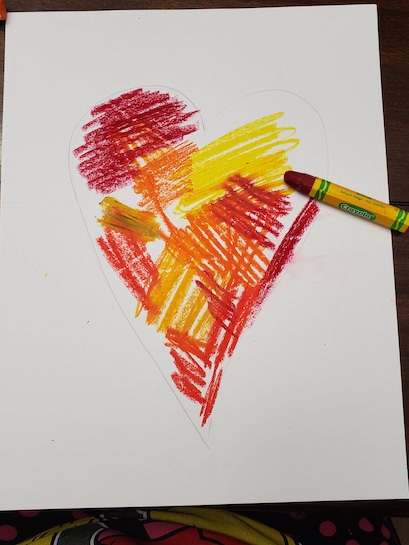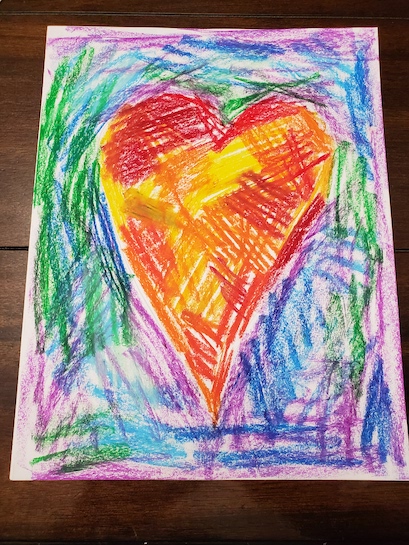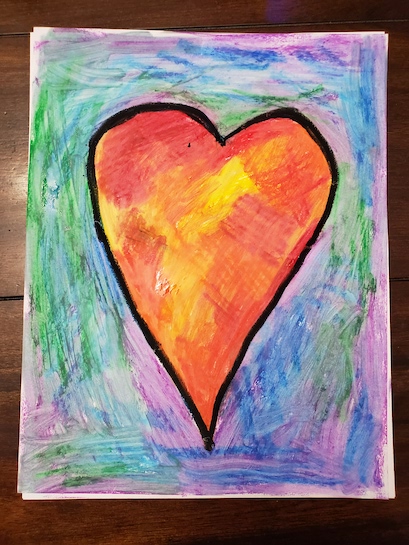Students will use contrasting colors to create emphasis from a simple symbol in the style of Jim Dine. Recommended for 3rd Graders.
Color: the visible range of reflected light. Color has three properties: hue (its name), value (light or darkness), and intensity (the brightness/dullness).
--Color schemes: groupings of colors that are related on the color wheel.
--Analogous: next to each other on the color wheel and very similar.
--Complementary: colors opposite each other on the color wheel which add interest when used next to each other.
--Cool Colors: colors on the color wheel associated with coolness: blue, green, and violet.
--Warm Colors: colors on the color wheel associated with warmth: red, yellow, and orange.
warm colors are red, orange, and yellow. Cool colors are blue, green, and purple.
Shape: a two-dimensional (flat) area enclosed by a line.
Contrast: refers to the arrangement of opposite elements, or using opposite qualities next to each other to create visual interest, excitement and drama. This lesson contrasts the color of the heart against its complimentary-colored background.
Emphasis (focal point): the part of an artwork that is emphasized in some way and attracts the eye and attention of the viewer; also called the center of interest.
Color Wheel: a tool in which colors are arranged in a specific order in a circle; used to explain color theory and show how colors relate to one another.
Jim Dine: Jim Dine was born (1935) in Cincinnati, Ohio. His family owned a hardware store and he developed a respect for everyday objects. This influence is evident with his use of everyday objects in his art. Sometimes he attached the actual tools or clothing to his canvases. Once he even attached a kitchen sink! Jim Dine loves the power of simple images. His graphic style and bold colors are closely associated with pop art, although he doesn’t consider himself a pop artist.
Pop Art: an art movement that emerged in the 1950s and flourished in the 1960s in America and Britain, drawing inspiration from sources in popular and commercial culture. Different cultures and countries contributed to the movement during the 1960s and 70s.
Prepare heart templates, if using.
Put only enough baby oil in cups to coat the bottom of the cup.
Using images of Dine’s work, discuss how emphasis in artwork is used.
Review complementary and warm and cool colors and how they create contrast.
Students will:


Lightly dab a cotton swab in baby oil. Use it to blend the colors inside the heart. Start with the light colors first.


Lesson written by Rachelle Roberts. Project Inspired by “Jim Dine Inspired Warm & Cool Hearts” by Heidi Furman from Newcastle Elementary. “Jim Dine Art, Bio, Ideas.” The Art Story. Tate. “Pop Art – Art Term.” Tate.
21st Century Thinking Skills
Observing, Making Connections, Visualizing, Comparing/contrasting, Finding Evidence, Decision Making, Evaluating.
WA State Learning Standards
(VA:Cr1.1.3) a. Elaborate on an imaginative idea.
(VA:Cr2.2.3) a. Demonstrate an understanding of the safe and proficient use of materials, tools, and equipment for a variety of artistic processes.
(VA:Re7.1.3) a. Speculate about processes an artist uses to create a work of art.
(VA:Re7.2.3) a. Determine messages communicated by an image: This happens if you talk about the meaning of the heart image.
(VA:Re9.1.3) a. Evaluate an artwork based on given criteria.
(VA:Cn11.1.3) a. Recognize that responses to art change depending on knowledge of the time and place in which it was made.
Please note: These lesson plans are intended for non-profit use only. Use of these plans for commercial purposes should give attribution to the Issaquah Schools Foundation and be accompanied by a nominal donation at www.isfdn.org/donate. Thank you.
Fueling Success for Every Student, Every School